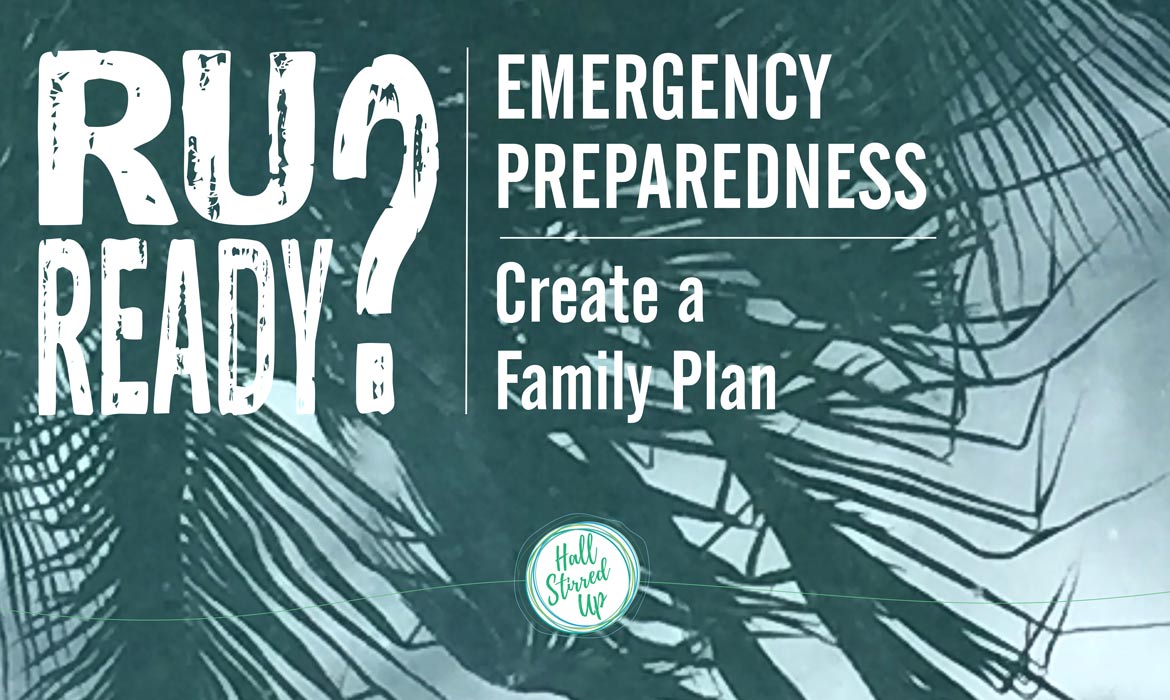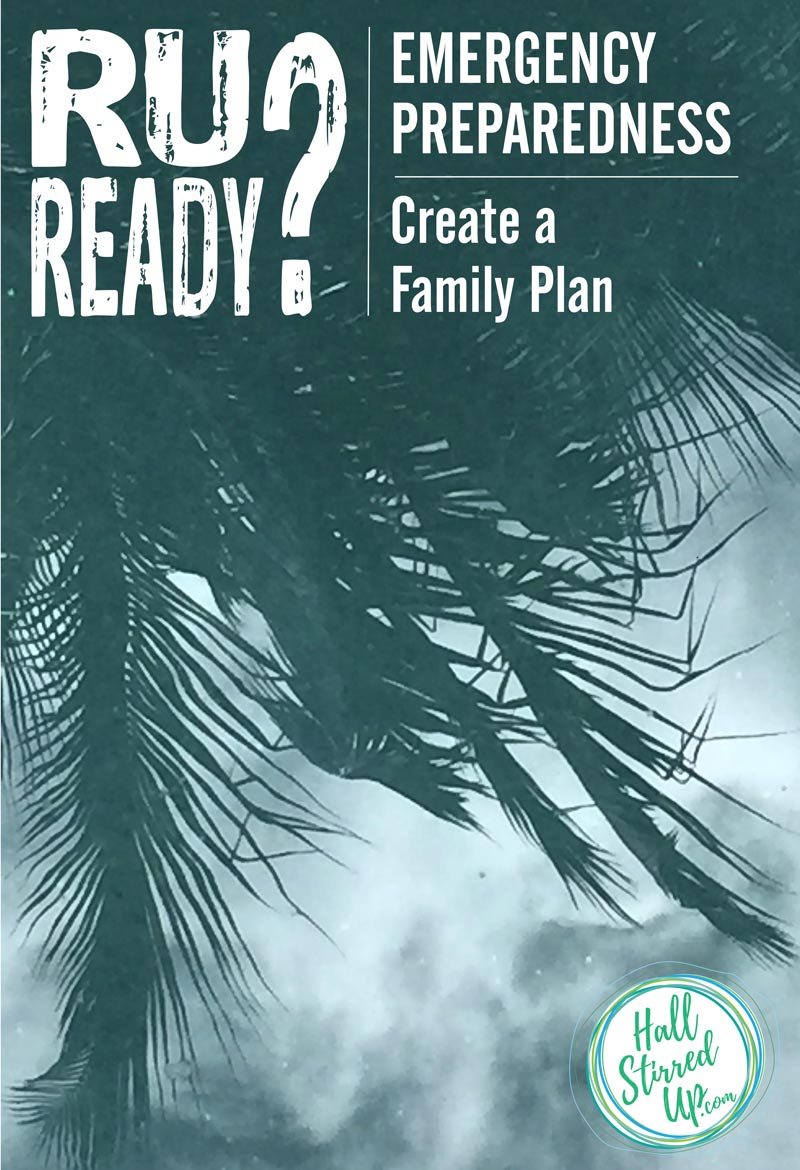
RU Ready? Emergency Preparedness – Create a Family Plan
It’s all over the news, and for too many, it’s now reality. Between the flooding in Houston, the earthquake in Mexico, and the devastation of Hurricanes Harvey, Maria and Irma, so many are facing loss of their loved ones, and of their way of life. My absolute heartfelt sympathies go out to everyone that has been affected by recent events. Below are some links where you can donate. Please contribute what you can. Every little bit will help.
The Red Cross
The Hispanic Federation (for Puerto Rico)
Las Vegas Victim’s Fund
Intermountain Western United States has been fortunate so far, but because of what we’ve witnessed, our family has decided to elevate the priority of preparedness. In the Intermountain region, preparedness is something of a preoccupation. The region sits on the edge of the world’s largest caldera, Yellowstone, and our Wasatch fault will go. It’s not a question of if, but when. Every estimate is that it will be a big quake. So, preparedness is something most residents are aware of and do practice to some degree, but it’s easy to be complacent. After watching Houston, Puerto Rico, and the Caribbean get hit so hard, it knocks you out of that complacency.
We need to be ready.
Because of that, I’ve decided to share some information that, can help you to get, or be better, prepared. In this first installment of a four-part series, we’ll talk about learning about the kind of emergency you may face, and creating a plan for your family.

Prepare for Natural Disasters
No matter where you live, chances are that sooner or later you’ll face some sort of disaster that will leave you without power, water, or access to goods and services. It could be a natural disaster like an earthquake, or a severe snow storm, flood, tornado, or hurricane. It could also be a manmade disaster such as a widespread power outage that requires you to shelter in place for a few days or longer.
It can be tough and it can be scary, but we can prepare for the disasters most likely to occur in our own area.
The first step in your own emergency preparedness plan should be to determine what situations you are likely to face. Take a few minutes to review the types of disasters your area is prone to. This is particularly important for a natural disaster. In California, it may be earthquakes or fire. The Intermountain west needs to be prepared for earthquakes, but severe snowstorms are also very likely. If you live in Florida or the South Eastern U.S. coastal regions, be prepared for hurricane season. If you live in the North East or south of the Great Lakes, you should get ready for big ice and snow storms. In the mid or southwest, chances are you’ll have to prepare for a tornado.
Prepare for Man-Made Emergencies
Next, think about possible man-made disasters. If you live near a dam, you may need a plan of action for flooding. If you live near a nuclear plant, you should think about evacuation if something were to happen at the plant. You get the idea. The disasters we prepare for will be different depending on our local environment.
Once you have your list of disasters that you need to prepare for, it may be a good idea to consider if and when you would try to prepare to stay at your home and ride it out, and when it may be time to evacuate. Obviously those decisions may be outside of your control, such as in the event of a mandatory evacuation, but there will also be plenty of times when the decision is up to you. Think about what makes the most sense to you and your family. If you are able to stay put, you can take care of issues as they pop up and prevent further damage. For example, if a storm blows out a window, you can board it up and prevent water from coming in.
At other times, it may be safer and more convenient to get out of the disaster’s way. For those cases as well as mandatory evacuation, think about where you would go. If staying with family or friends is not an option, find an area you may want to travel to and get the numbers of a few hotels. Things move fast when a storm hits and evacuations are ordered, so you don’t want to waste time trying to make decisions only to find you’ve lost out on a hotel room for yourself and your loved ones. Shelters are not the most comfortable place to make it through a disaster, so they should always be considered a last resort.
Make An Emergency Preparedness Plan For Your Family
Let’s face it. You and your loved ones will most likely encounter a natural disaster or similar emergency event at some time that requires you to jump into action to stay safe and sound. Doing so will become much easier when you go in prepared and with a plan. Here are three basic questions to ask that will help you formulate an emergency preparedness plan for your family.
Where Will You Go?
The first question you need to ask yourself is where you will go when an emergency arises. Will you stay at home and shelter in place? Will you head out of town and evacuate? If you are heading out, where will you go and where will you stay?
These are important questions and you don’t want to make those decisions when you are in the middle of a disaster. Those are stressful times and it can be hard to make smart decisions quickly in those situations. A big part of your emergency preparedness plan should be to think through possible scenarios and then get the information you need ahead of time. For example, figure out what routes you can take to get out of the area, determine where you want to go if possible, and then get the contact information for a hotel or the people youíll be staying with.
How Will You Stay In Touch?
There is nothing scarier than not being able to get in touch with loved ones during a disaster or emergency event. Just as important is being able to get news and emergency alerts or announcements. Think about how you will accomplish this both while you’re on the road and when you’re staying in your home or emergency shelter.
Making sure everyone has a mobile phone is a great start. And remember! Keeping chargers, including car chargers with you is a must. An additional battery, or a backup power supply will also be very useful. Try to make the battery power last as long as possible, so use it sparingly, and it’s also important to talk to your kids about conserving battery power, so speak to them ahead of a disaster and remind them regularly.
Have a Backup Plan
Don’t rely on just your smart phone for news and communication. A backup plan will come in handy when you can’t get a good connection or run out of power on your device. Designate a meeting point or a person that everyone contacts when you can’t get a hold of each other. Have a backup solution for finding out what’s going on, like a weather alert radio.
What Preparedness Supplies Do You Need?
Start with the basics you need for survival including food, water, shelter, and medication. Don’t forget about your pets. From there, start thinking about creature comforts like light, entertainment, and things that will help keep you and your family occupied. Having a headlamp and a good book can make waiting out a power outage a lot more pleasant. Add a cup of hot chocolate made with a camping stove, hot water, and instant cocoa mix will make it even more pleasant.
You can be ready
The more prepared you are, the safer and more comfortable you’ll be when the inevitable happens. Depending on what natural disaster you face, where you live, who is part of your family, and simple things like weather will determine the supplies you’ll need to have on hand. Get the family involved so that everyone knows what to do. Be prepared and you’ll greatly increase your chances of making it through the emergency or disaster just fine.
Next week I’ll talk about the top 5 supplies that should be part of your emergency preparedness.
While you’re here, sign up to receive updates and direct links to my posts and newest free printables! Subscribers receive direct links to my free printables plus exclusive digital desktop images of each month’s printable. Don’t miss out!

Leave a Reply